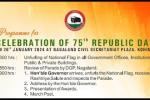

MONGMONG - SANGTAM TRIBE
After toiling for several months during the year and when the crops are ripened for harvest, the green signal to start of the celebration of mongmong festival is given by the village priest called "BEBURU" with due prayers and rites. At dead of the night the priest will announce/proclaim that" ZANGNYUO MONGMONG NUNG EH-LEHE". The next morning another priest will repeat the proclamation. Then the villagers will begin preparation for the festival by accumulating foodstuffs, firewood and special wine like Rohi and Madhu etc. The announcement made in the morning is the correct information. The proxy announcement made at dead of the night denotes separation of the spirit of the dead from the living during Mongmong festival. Also nobody would like to inherit the sins of the dead and any kind of sinful deeds. Thus through Mongmong festival a line is drawn between the dead and the living.
Mongmong festival, which means togetherness forever is very cautiously observed every year and stretches over six days. The object is to have a good harvest,food grains for which the villagers toiled for the whole year. The figure ‘Six’also bears a great significance among our forefathers as the figure ‘Seven’ was among the Hebrews. For example, when a man brings enemy’s head from war, he keeps himself undefined and observes genna for six days. A male baby is christened on the sixth day. If a man dies, the deceased family mourn for six days
Each day of the festival has its own significance. Thus, the first day that is September 1 is called ‘SINGKITHSA’. This day is marked by closing of all transactions relating to purchase of domestic animals like Pigs, Cows, Mithuns and rope them also preparation and collecting of foodstuffs. The villagers also engaged themselves in collection of vegetables, millet, and firewood from the old fields.
While collection of firewood and water continuous on the second day the roped domestic animals are also killed. After setting aside some portions for the feast the meat is distributed amongst the team members of the group called ATIRü and AKHINGRU. These male and female groups are organized according to the group primarily for working together in the fields of every member of the team in turn. During mongmong festival, special meals are arranged in the house o fthe treasurer of the respective groups/ teams. On the other hand, the meat of animals killed by rich individual is generally shared among relatives, neighbor sand friends. The day is called "SINGKITHSA.
The third day is MUSUYANGTAP day of worshipping the 3 oven stones by one and all. In the early morning of third day of celebration the oldest women of the household perform the ritual by placing gum rice shaped into balls on the top of the 3 stones and also pours a little wine upon these stones believing that the God (LIJABA) is represented by these stones. Till the rituals completed nobody in the house is allowed to taste food and even animals are not fed. This performance normally takes a short time only. But great care is taken and during the ritual lest it is eaten up by some domestic animals which is believed to be the sign of some misfortune or wrath of the evil.
On these three days’ villagers will not go either to field or outside the village as according to the belief these actions would bring calamities and would damages the crops. Again at dawn the priest would go to the village well and draw water first very carefully followed by other people waiting there. But each one of them must cover his or her head with green leaves lest he/she is attacked by cholera. The day is celebrated with children playing among themselves with gay dresses and the young people in their best gathered in dormitory and exchange songs of bravery. In course of time they are usually joined by their girlfriends. The whole day is devoted to drinking of rice-bear,dances including tug of war and other merrymaking activities etc.
The fourth day is called ‘KIKHALANGPI’. The male population of the village gives a face-lift to the village. Here again the priest will first start clearing the weeds then he is followed by all other villagers. Path leading to the fields, inter-village road, village wells and springs are cleaned. On returning home every grown up male member will contribute meat and wine and feast together in the house of the village priest. There they reaffirm mutual friendships. In short it is day of special gathering and feast. The wife of the house puts chilies, ginger and cotton in green leaves called ‘TSIDONG’ and puts them in the field or outside the village as according to the belief the sections would ward off calamities and prevent damage of crops.
The fifth day is called ‘SHILANG WUBA NYUMONG’. This day the villagers pay visit to relatives, friend and neighboring villages. Also sharing of meals,drinks and exchange of gifts in the form of meat as presentation.
The last day of the festival is called ‘AKATISINGKITHSA’. From this day harvesting starts. On successful completion of six days’ celebration of Mongmong, the Sangtam Nagas believe that their God is well pleased and hope for blessing from him by having rich harvest and good health in the family.






